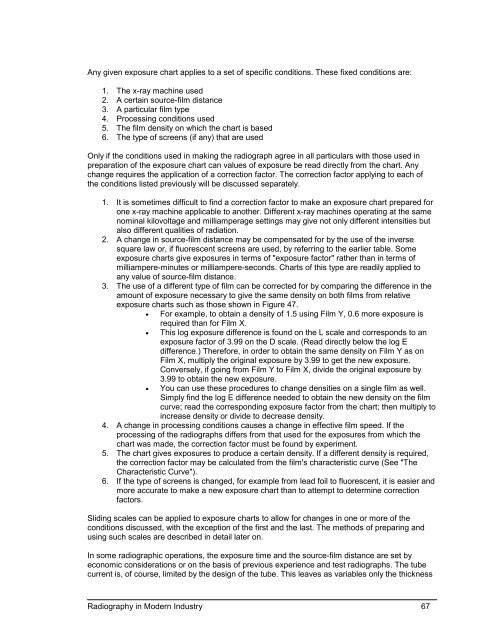Radiography in Modern Industry - Kodak
Radiography in Modern Industry - Kodak
Radiography in Modern Industry - Kodak
You also want an ePaper? Increase the reach of your titles
YUMPU automatically turns print PDFs into web optimized ePapers that Google loves.
Any given exposure chart applies to a set of specific conditions. These fixed conditions are:1. The x-ray mach<strong>in</strong>e used2. A certa<strong>in</strong> source-film distance3. A particular film type4. Process<strong>in</strong>g conditions used5. The film density on which the chart is based6. The type of screens (if any) that are usedOnly if the conditions used <strong>in</strong> mak<strong>in</strong>g the radiograph agree <strong>in</strong> all particulars with those used <strong>in</strong>preparation of the exposure chart can values of exposure be read directly from the chart. Anychange requires the application of a correction factor. The correction factor apply<strong>in</strong>g to each ofthe conditions listed previously will be discussed separately.1. It is sometimes difficult to f<strong>in</strong>d a correction factor to make an exposure chart prepared forone x-ray mach<strong>in</strong>e applicable to another. Different x-ray mach<strong>in</strong>es operat<strong>in</strong>g at the samenom<strong>in</strong>al kilovoltage and milliamperage sett<strong>in</strong>gs may give not only different <strong>in</strong>tensities butalso different qualities of radiation.2. A change <strong>in</strong> source-film distance may be compensated for by the use of the <strong>in</strong>versesquare law or, if fluorescent screens are used, by referr<strong>in</strong>g to the earlier table. Someexposure charts give exposures <strong>in</strong> terms of "exposure factor" rather than <strong>in</strong> terms ofmilliampere-m<strong>in</strong>utes or milliampere-seconds. Charts of this type are readily applied toany value of source-film distance.3. The use of a different type of film can be corrected for by compar<strong>in</strong>g the difference <strong>in</strong> theamount of exposure necessary to give the same density on both films from relativeexposure charts such as those shown <strong>in</strong> Figure 47.• For example, to obta<strong>in</strong> a density of 1.5 us<strong>in</strong>g Film Y, 0.6 more exposure isrequired than for Film X.• This log exposure difference is found on the L scale and corresponds to anexposure factor of 3.99 on the D scale. (Read directly below the log Edifference.) Therefore, <strong>in</strong> order to obta<strong>in</strong> the same density on Film Y as onFilm X, multiply the orig<strong>in</strong>al exposure by 3.99 to get the new exposure.Conversely, if go<strong>in</strong>g from Film Y to Film X, divide the orig<strong>in</strong>al exposure by3.99 to obta<strong>in</strong> the new exposure.• You can use these procedures to change densities on a s<strong>in</strong>gle film as well.Simply f<strong>in</strong>d the log E difference needed to obta<strong>in</strong> the new density on the filmcurve; read the correspond<strong>in</strong>g exposure factor from the chart; then multiply to<strong>in</strong>crease density or divide to decrease density.4. A change <strong>in</strong> process<strong>in</strong>g conditions causes a change <strong>in</strong> effective film speed. If theprocess<strong>in</strong>g of the radiographs differs from that used for the exposures from which thechart was made, the correction factor must be found by experiment.5. The chart gives exposures to produce a certa<strong>in</strong> density. If a different density is required,the correction factor may be calculated from the film's characteristic curve (See "TheCharacteristic Curve").6. If the type of screens is changed, for example from lead foil to fluorescent, it is easier andmore accurate to make a new exposure chart than to attempt to determ<strong>in</strong>e correctionfactors.Slid<strong>in</strong>g scales can be applied to exposure charts to allow for changes <strong>in</strong> one or more of theconditions discussed, with the exception of the first and the last. The methods of prepar<strong>in</strong>g andus<strong>in</strong>g such scales are described <strong>in</strong> detail later on.In some radiographic operations, the exposure time and the source-film distance are set byeconomic considerations or on the basis of previous experience and test radiographs. The tubecurrent is, of course, limited by the design of the tube. This leaves as variables only the thickness<strong>Radiography</strong> <strong>in</strong> <strong>Modern</strong> <strong>Industry</strong> 67
















